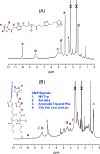Synergistic Combination of Antimicrobial Peptides and Cationic Polyitaconates in Multifunctional PLA Fibers
- PMID: 37862451
- PMCID: PMC10852355
- DOI: 10.1021/acsabm.3c00576
Synergistic Combination of Antimicrobial Peptides and Cationic Polyitaconates in Multifunctional PLA Fibers
Abstract
Combining different antimicrobial agents has emerged as a promising strategy to enhance efficacy and address resistance evolution. In this study, we investigated the synergistic antimicrobial effect of a cationic biobased polymer and the antimicrobial peptide (AMP) temporin L, with the goal of developing multifunctional electrospun fibers for potential biomedical applications, particularly in wound dressing. A clickable polymer with pendent alkyne groups was synthesized by using a biobased itaconic acid building block. Subsequently, the polymer was functionalized through click chemistry with thiazolium groups derived from vitamin B1 (PTTIQ), as well as a combination of thiazolium and AMP temporin L, resulting in a conjugate polymer-peptide (PTTIQ-AMP). The individual and combined effects of the cationic PTTIQ, Temporin L, and PTTIQ-AMP were evaluated against Gram-positive and Gram-negative bacteria as well as Candida species. The results demonstrated that most combinations exhibited an indifferent effect, whereas the covalently conjugated PTTIQ-AMP displayed an antagonistic effect, potentially attributed to the aggregation process. Both antimicrobial compounds, PTTIQ and temporin L, were incorporated into poly(lactic acid) electrospun fibers using the supercritical solvent impregnation method. This approach yielded fibers with improved antibacterial performance, as a result of the potent activity exerted by the AMP and the nonleaching nature of the cationic polymer, thereby enhancing long-term effectiveness.
Keywords: antimicrobial; antimicrobial peptide; cationic polymers; fibers; supercritical impregnation.
Conflict of interest statement
The authors declare no competing financial interest.
Figures






Similar articles
-
Electrospun Polylactic Acid-Based Fibers Loaded with Multifunctional Antibacterial Biobased Polymers.ACS Appl Polym Mater. 2022 Sep 9;4(9):6543-6552. doi: 10.1021/acsapm.2c00928. Epub 2022 Aug 26. ACS Appl Polym Mater. 2022. PMID: 36590989 Free PMC article.
-
Novel antimicrobial peptides isolated from the skin secretions of Hainan odorous frog, Odorrana hainanensis.Peptides. 2012 Jun;35(2):285-90. doi: 10.1016/j.peptides.2012.03.007. Epub 2012 Mar 16. Peptides. 2012. PMID: 22450466
-
Toward Infection-Resistant Surfaces: Achieving High Antimicrobial Peptide Potency by Modulating the Functionality of Polymer Brush and Peptide.ACS Appl Mater Interfaces. 2015 Dec 30;7(51):28591-605. doi: 10.1021/acsami.5b10074. Epub 2015 Dec 21. ACS Appl Mater Interfaces. 2015. PMID: 26641308
-
Regiospecific vs. non regiospecific click azide-alkyne polymerization: In vitro study of water-soluble antibacterial poly(amide aminotriazole)s.Mater Sci Eng C Mater Biol Appl. 2021 Jun;125:112113. doi: 10.1016/j.msec.2021.112113. Epub 2021 Apr 17. Mater Sci Eng C Mater Biol Appl. 2021. PMID: 33965117
-
Bioinspired Cationic Antimicrobial Polymers.Angew Chem Int Ed Engl. 2025 Jun 10;64(24):e202503738. doi: 10.1002/anie.202503738. Epub 2025 May 15. Angew Chem Int Ed Engl. 2025. PMID: 40238589 Free PMC article. Review.
Cited by
-
Insights into Liposomal and Gel-Based Formulations for Dermatological Treatments.Gels. 2025 Mar 26;11(4):245. doi: 10.3390/gels11040245. Gels. 2025. PMID: 40277680 Free PMC article. Review.
-
Recent approaches in the application of antimicrobial peptides in food preservation.World J Microbiol Biotechnol. 2024 Sep 9;40(10):315. doi: 10.1007/s11274-024-04126-4. World J Microbiol Biotechnol. 2024. PMID: 39249587 Review.
References
-
- Chiloeches A.; Fernández-García R.; Fernández-García M.; Mariano A.; Bigioni I.; Scotto d’Abusco A.; Echeverría C.; Muñoz-Bonilla A. PLA and PBAT-Based Electrospun Fibers Functionalized with Antibacterial Bio-Based Polymers. Macromol. Biosci. 2023, 23 (1), 2200401.10.1002/mabi.202200401. - DOI - PubMed
Publication types
MeSH terms
Substances
Grants and funding
LinkOut - more resources
Full Text Sources
Medical
